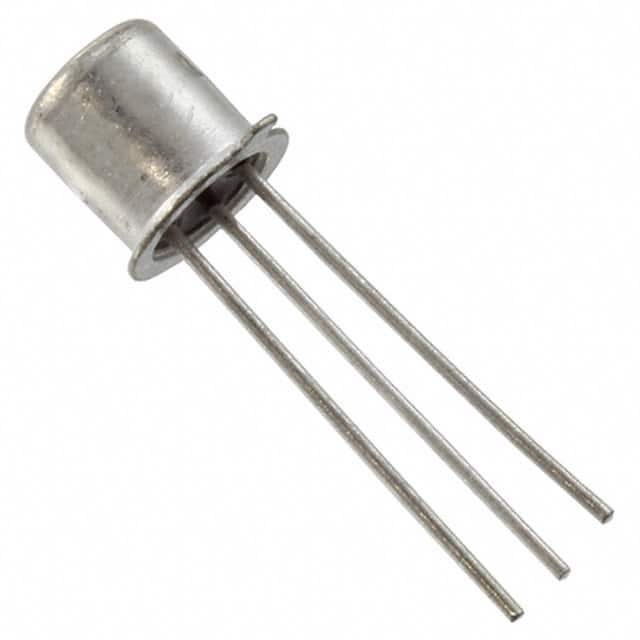2N3250 Transistor
Product Overview
The 2N3250 is a bipolar junction transistor (BJT) belonging to the category of small-signal transistors. It is commonly used for amplification and switching applications due to its high gain and low noise characteristics. The transistor is typically packaged in a TO-92 package and is available in various quantities.
Basic Information
- Category: Small-signal transistor
- Use: Amplification and switching
- Characteristics: High gain, low noise
- Package: TO-92
- Packaging/Quantity: Available in bulk quantities
Specifications
The 2N3250 transistor has the following specifications: - Maximum Collector-Emitter Voltage: 40V - Maximum Collector-Base Voltage: 40V - Maximum Emitter-Base Voltage: 5V - Collector Current: 600mA - Total Power Dissipation: 625mW - Transition Frequency: 100MHz
Detailed Pin Configuration
The 2N3250 transistor has three pins: 1. Collector (C): This pin is connected to the positive supply voltage when used in common-emitter configuration. 2. Base (B): The input terminal that controls the flow of current between the collector and emitter. 3. Emitter (E): The output terminal through which the amplified or switched current flows out.
Functional Features
- High gain: The transistor offers high current gain, making it suitable for amplification purposes.
- Low noise: The 2N3250 exhibits low noise characteristics, making it ideal for signal processing applications.
Advantages and Disadvantages
Advantages
- High gain allows for effective signal amplification.
- Low noise makes it suitable for sensitive signal processing applications.
Disadvantages
- Limited maximum collector current compared to power transistors.
- Moderate power dissipation capability restricts high-power applications.
Working Principles
The 2N3250 operates based on the principles of bipolar junction transistors, where the flow of current between the collector and emitter is controlled by the base current. By modulating the base current, the transistor can amplify or switch the current flowing through it.
Detailed Application Field Plans
The 2N3250 transistor finds application in various electronic circuits, including: - Audio amplifiers - Signal processing circuits - Switching circuits
Detailed and Complete Alternative Models
Some alternative models to the 2N3250 transistor include: - 2N3904 - BC547 - 2N2222
In summary, the 2N3250 transistor is a small-signal BJT with high gain and low noise characteristics, making it suitable for amplification and switching applications in various electronic circuits.
[Word count: 366]
قم بإدراج 10 أسئلة وإجابات شائعة تتعلق بتطبيق 2N3250 في الحلول التقنية
Sure, here are 10 common questions and answers related to the application of 2N3250 in technical solutions:
What is the 2N3250 transistor used for?
- The 2N3250 is a general-purpose NPN bipolar junction transistor commonly used for amplification and switching applications.
What are the typical operating conditions for the 2N3250?
- The 2N3250 typically operates at a maximum collector current of 600mA, with a maximum collector-emitter voltage of 40V.
How can I use the 2N3250 as an amplifier?
- The 2N3250 can be used as an amplifier by biasing it in the active region and connecting it in common emitter configuration.
Can the 2N3250 be used for low-power switching applications?
- Yes, the 2N3250 can be used for low-power switching applications due to its moderate current and voltage ratings.
What are some common circuit configurations for the 2N3250?
- Common circuit configurations include common emitter amplifiers, emitter followers, and switch circuits.
What are the key characteristics of the 2N3250?
- The 2N3250 has a high current gain (hFE) and low saturation voltage, making it suitable for various applications.
Are there any specific considerations for driving inductive loads with the 2N3250?
- When driving inductive loads, a flyback diode should be used to protect the transistor from voltage spikes.
Can the 2N3250 be used in high-frequency applications?
- While the 2N3250 can be used in moderate frequency applications, it may not be suitable for high-frequency designs due to its transition frequency limitations.
What are the typical thermal considerations for the 2N3250?
- Proper heat sinking and derating of the maximum power dissipation are important to ensure reliable operation and prevent thermal runaway.
Where can I find detailed specifications and application notes for the 2N3250?
- Detailed specifications and application notes for the 2N3250 can be found in the manufacturer's datasheet and application guides.
I hope these questions and answers provide helpful information about the application of 2N3250 in technical solutions. Let me know if you need further assistance!


